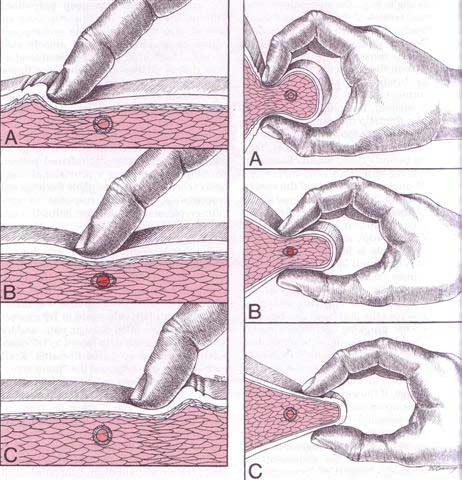Muscles Matter
Trigger Point Therapy
Trigger Point Therapy
What is it?
Trigger point therapy is bodywork that involves applying pressure in a specific and safe manner to tender muscle tissue in order to relieve pain and dysfunction in other parts of the body.
What are Trigger Points?

A trigger point is a hyperirritable spot, usually within a taut band of skeletal muscle, fascia, joint capsule or ligaments. (Travell, Simmons, 1983) It is point tender on site, often exhibits a predictable pain referral pattern and causes a shortening of the effected muscle. Trigger points are likely to be one of the main causes of stiff joints and restricted range of motion. If you have pain and there is no evidence of muscle wasting or numbness or loss of sensation, you most likley have trigger points.
Trigger points are also called muscle callous, muscular rheumatism, chronic rheumatism, myogelous and fibrositis. Medical terminology confusion has hampered the medical understanding of muscular pain disorders. (Travell, Simmon, 1983) However, Various studies have revealed the trigger point to be an area both of increased metabloism and decreased circulation. This local vasoconstriction (contraction or tightening of blood vessels) or ischemia (lack of blood flow) is likley a reflexive attempt by the body to contain the uncontrolled metabolic processes at the site.
Trigger points are different from acupressure points. Acupressure points are concentrations of energy or blockages of the body's energy pathways. Trigger points are physical phenomena that can be felt by touching. With Fibromyalgia, there is no referral pattern or pain or taut bands present with tender points. A swedish study demonstrated a relationship between pain levels and myoglobin (the oxygen-carrying protein in muscle tissue) in patients with Fibromyalgia. The pain in fibromyalgia is due to myoglobin leaking from the muscles. Along with pain reduction after massage, there was a gradule reduction in the levels of myoglobin within the patients blood. (Goldberg, 1998) Therefore, treatment for Fibromyalgia patients are shorter, and more frequent. Regularity is important for lasting benefits.
What Causes Trigger Points?
Trigger points are idiopathic, meaning that they don't really know why we get them. Travell, a leader in research into trigger points; had several theories as to why they develop. His theoris are: initial trauma, such as an acute strain/sprain, causing muscular overload giving rise to the trigger point, over work as in to much exercise when your body is not ready for it, fatigue and chilling the muscle. It can also be referred pain from organs, and emotional stresses. Specific factors that activate trigger points include leaving the muscle in a shortened postion for several hrs, for example when you sleep.
Perpetuating factors include: Mechanical stresses, including bony symmetries such as if you have one leg that is longer than the other, postural stresses, muscle constriction, nutritional inadequacies (such as vitamin B, C or folic acid) depression, anxiety, chronic infection and impaired sleep.
What is the Purpose of Trigger Point Therapy?
The purpose of trigger point therapy is to eliminate pain and to re-educate the muscles to perform pain-free habits. After several treatments, the swelling and stiffness of neuromuscular pain is reduced. Range of motion is increased, tension is relieved, and circulation, flexibility and coordination are improved.
Trigger point therapy will help you improve your natural ability to maintain an active lifestyle.
Who should get trigger point Therapy?
Trigger points have been documented as a source of muscular pain in people from as early as infancy and childhood. Of course, the amount of pressure used varies with every patient. We are all different, and each individual treatment is tailored to fit your specific condition and pain tolerance, ensuring that you have the best results possible.

